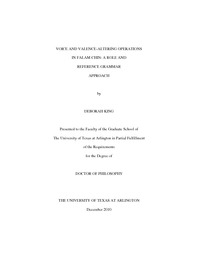
ATTENTION: The works hosted here are being migrated to a new repository that will consolidate resources, improve discoverability, and better show UTA's research impact on the global community. We will update authors as the migration progresses. Please see MavMatrix for more information.
Show simple item record
| dc.contributor.author | King, Deborah | en_US |
| dc.date.accessioned | 2011-03-03T21:51:47Z | |
| dc.date.available | 2011-03-03T21:51:47Z | |
| dc.date.issued | 2011-03-03 | |
| dc.date.submitted | January 2010 | en_US |
| dc.identifier.other | DISS-10853 | en_US |
| dc.identifier.uri | http://hdl.handle.net/10106/5445 | |
| dc.description.abstract | This dissertation describes and analyzes voice and valence-altering operations in Falam Chin, a Tibeto-Burman language of Burma. The data is explained within the framework of Role and Reference Grammar (RRG), which supplies several key concepts particularly useful for generalizing the behavior of the Falam Chin operations. The first is RRG's system of semantic decomposition, based on Dowty (1979), which is used to formulate each predicate's underlying logical structure (LS). Second is the concept of macroroles, generalized semantic roles actor and undergoer, which are assigned to the arguments of a predicate according to a hierarchy of LS positions. M-transitivity refers to the number of macroroles assigned to a given predicate (Van Valin & LaPolla 1997; Van Valin 2005).Within this framework, each of the primary voice and valence-altering operations of Falam Chin are shown to be lexical operations which affect the underlying LS and/or macrorole assignment of the base predicate. Causatives and applicatives are valence-raising operations which fuse two LSs by means of a lexical rule, such that their arguments are treated as the arguments of a single predicate. On the other hand, reflexives, reciprocals, and middles assign coreferentiality to two arguments of the base predicate, after which they lower M-transitivity by joining the macroroles of the two coreferential arguments into a single macrorole. Finally, antipassives lower M-transitivity by blocking macrorole assignment to the lower-ranking argument of the base predicate.While Falam Chin displays both dependent-marking and head-marking characteristics, this dissertation argues that it is a fundamentally head-marking language. As is characteristic of head-marking languages, Falam Chin's NPs are in semantic apposition to its cross-reference pronominals, which are the true core arguments. In light of this, a number of unusual features of Falam Chin's voice and valence-altering operations are revealed to be natural results of its head-marking makeup. Furthermore, as claimed by Nichols (1986), head-marking languages tend to downplay syntactic distinctions in favor of semantic and pragmatic ones, a characteristic evident in Falam Chin's preference for lexical operations with semantic and pragmatic functions. | en_US |
| dc.description.sponsorship | Edmondson, Jerold | en_US |
| dc.language.iso | en | en_US |
| dc.publisher | Linguistics | en_US |
| dc.title | Voice And Valence-altering Operations In Falam Chin: A Role And Reference Grammar Approach | en_US |
| dc.type | Ph.D. | en_US |
| dc.contributor.committeeChair | Edmondson, Jerold | en_US |
| dc.degree.department | Linguistics | en_US |
| dc.degree.discipline | Linguistics | en_US |
| dc.degree.grantor | University of Texas at Arlington | en_US |
| dc.degree.level | doctoral | en_US |
| dc.degree.name | Ph.D. | en_US |
Files in this item
- Name:
- King_uta_2502D_10853.pdf
- Size:
- 4.750Mb
- Format:
- PDF
This item appears in the following Collection(s)
Show simple item record


